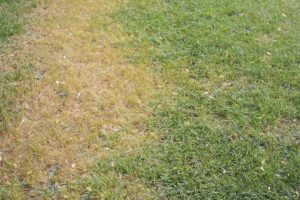
Lawn fungi like Brown Patch can cause damage and unsightly lawn appearances.
Lawn fungi can quickly undo the work you have put into your lawn. Fungi spread quickly, and once they spread across most of your lawn, they can be difficult to stop. Although many of the symptoms of fungi are similar, they are unique in their ways. Fungi are spread through wind and rain but can also be distributed by a lawnmower. If you are unaware of a fungus on your lawn, you may be spreading spores unknowingly. Unfortunately, a fungus only presents itself once the disease has taken hold under the right environmental conditions. The first step in treating these lawn diseases is to spot the symptoms and know what environmental conditions allow the fungus to thrive.
There are a few common lawn fungi that can infect your turfgrass, including Brown Patch, Fusarium Blight, Dollar Spot, Pythium Blight, Rust, and Mushrooms. We discussed the causes of mushroom growth last week. Below we discuss the other common destructive lawn fungi and diseases and what you can do to prevent them from severely damaging your lawn.
Brown Patch
One of the most widespread symptoms of lawn fungi, Brown Patch, can infect various common turfgrasses, including tall fescue. Look for circular areas of brown and dead grass surrounded by a narrow, dark ring. For tall fescue, the fungus may appear on scattered blades of grass so that the whole lawn has a tannish cast rather than the vibrant green you want.
Fusarium Blight
When lawns are infected with Fusarium Blight, they display small, circular grayish to straw-colored areas of dead grass. These circles can range from a few inches up to a foot in diameter. Some plants in the center may thrive, giving the area a “frog-eye” appearance.
Dollar Spot
This lawn disease is noticeable by the appearance of small, circular, tannish spots about the size of a silver dollar. The spots may merge to form large, irregular areas. Also, look for white cottony mycelium growth around the edges of the spots. Individual leaf blades may also have hourglass-shaped lesions.
Pythium Blight
Symptoms of these lawn fungi are small, circular spots about two to six inches in diameter that run together. Blackened leaf blades rapidly wither, turn a reddish-brown, lie flat, stick together, and appear greasy. Roots may be brown, and in humid conditions, masses of fungal mycelium might appear.
Rust
Rust is another common lawn disease, as all grasses are susceptible. The symptoms are irregular patches of weak turf-covered with rust-colored growth or spores.
Conditions That Encourage Lawn Fungi
One of the best ways to stop lawn fungus from spreading is to know what causes their growth. The conditions that encourage fungi are:
- Drought
- Overwatering
- Over-fertilizing or excess nitrogen
- Mowing grass too low
- Compacted soil
- High heat and humidity, especially during the overnight hours
How to Prevent Lawn Diseases
You can take a few steps to prevent the growth of various lawn fungi in your yard. These include:
- Mow your grass properly: mowing higher is generally better than mowing shorter. As your grass’s health decreases, it’s easier for weeds and fungus to take hold.
- Remove lawn clippings: Remove your lawn clippings after mowing to stop fungus spores from spreading during the summer months.
- Aerate your lawn: if your soil is compacted, aerating your yard will help improve the health of your turf.
- Apply preventative fungicides: these applications should be started before the onset of the environmental conditions that allow the fungi to spread and cause damage.
- Water your lawn in the morning: It’s best to water your lawn between 6 and 10 am. This gives the grass time to absorb water and gives the sun plenty of time to dry the turf during the day.
- Keep thatch levels no higher than half an inch. Thatch levels can be managed with proper aeration.
In general, you should be careful to perform the best cultural practices for your specific turfgrass.
Scientific Plant Service Is Your Go-To Source In Landscape Healthcare
Scientific Plant Service, located in Baltimore, is a privately owned corporation, chartered in Maryland in 1957 by Frank J. Burke. We started as a full-service Arborists specializing in the care of shade trees and ornamental shrubs, but today we are a Lawn Care company that is a huge part of the community. From aquatic environments and snow management to deer and mole control, SPS has services tailored specifically for your lawn and landscape.
We offer services in Maryland, Washington, DC, and Virginia, including: Harford, Baltimore, Carroll, Frederick, Howard, Anne Arundel, Montgomery, Prince Georges, Talbot, Queen Anne’s, Calvert counties in MD, as well as Loudoun County, Fairfax County, Arlington, Alexandria, and Falls Church in VA. For more information, contact us online, or call us at 410-321-0970. Be sure to follow us on Facebook, Twitter, LinkedIn, and Pinterest!

